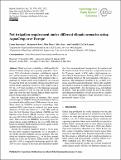Por favor, use este identificador para citar o enlazar a este item:
http://hdl.handle.net/10261/277923COMPARTIR / EXPORTAR:
 SHARE SHARE
 CORE
BASE CORE
BASE
|
|
| Visualizar otros formatos: MARC | Dublin Core | RDF | ORE | MODS | METS | DIDL | DATACITE | |

| Título: | Net irrigation requirement under different climate scenarios using AquaCrop over Europe |
Autor: | Busschaert, Louise; de Roos, Shannon; Thiery, Wim; Raes, Dirk; De Lannoy, Gabrielle | Fecha de publicación: | 18-jul-2022 | Editor: | Copernicus Publications | Citación: | Hydrology and Earth System Sciences 26(14): 3731-3752 (2022) | Resumen: | Global soil water availability is challenged by the effects of climate change and a growing population. On average, 70 % of freshwater extraction is attributed to agriculture, and the demand is increasing. In this study, the effects of climate change on the evolution of the irrigation water requirement to sustain current crop productivity are assessed by using the Food and Agriculture Organization (FAO) crop growth model AquaCrop version 6.1. The model is run at resolution over the European mainland, assuming a general C3-type of crop, and forced by climate input data from the Inter-Sectoral Impact Model Intercomparison Project phase three (ISIMIP3). First, the AquaCrop surface soil moisture (SSM) forced with two types of ISIMIP3 historical meteorological datasets is evaluated with satellite-based SSM estimates in two ways. When driven by ISIMIP3a reanalysis meteorology, daily simulated SSM values have an unbiased root mean square difference of 0.08 and 0.06 m3 m−3, with SSM retrievals from the Soil Moisture Ocean Salinity (SMOS) and Soil Moisture Active Passive (SMAP) missions, respectively, for the years 2015–2016 (2016 is the end year of the reanalysis data). When forced with ISIMIP3b meteorology from five global climate models (GCMs) for the years 2015–2020, the historical simulated SSM climatology closely agrees with the satellite-based SSM climatologies. Second, the evaluated AquaCrop model is run to quantify the future irrigation requirement, for an ensemble of five GCMs and three different emission scenarios. The simulated net irrigation requirement (Inet) of the three summer months for a near and far future climate period (2031–2060 and 2071–2100) is compared to the baseline period of 1985–2014 to assess changes in the mean and interannual variability of the irrigation demand. Averaged over the continent and the model ensemble, the far future Inet is expected to increase by 22 mm per month (+30 %) under a high-emission scenario Shared Socioeconomic Pathway (SSP) 3–7.0. Central and southern Europe are the most impacted, with larger Inet increases. The interannual variability in Inet is likely to increase in northern and central Europe, whereas the variability is expected to decrease in southern regions. Under a high mitigation scenario (SSP1–2.6), the increase in Inet will stabilize at around 13 mm per month towards the end of the century, and interannual variability will still increase but to a smaller extent. The results emphasize a large uncertainty in the Inet projected by various GCMs. | Descripción: | Project Co-ordinators: Dr. Jose Alfonso Gómez Calero (Instituto de Agricultura Sostenible (IAS-CISC), Dr. Weifeng Xu (Fujian Agriculture and Forest University, FAFU). -- Trabajo desarrollado bajo la financiación del proyecto “Soil Hydrology research platform underpinning innovation to manage water scarcity in European and Chinese cropping Systems” (773903), coordinado por José Alfonso Gómez Calero, investigador del Instituto de Agricultura Sostenible (IAS). | Versión del editor: | https://doi.org/10.5194/hess-26-3731-2022 | URI: | http://hdl.handle.net/10261/277923 | DOI: | 10.5194/hess-26-3731-2022 | ISSN: | 1027-5606 | E-ISSN: | 1607-7938 |
| Aparece en las colecciones: | (IAS) Artículos |
Ficheros en este ítem:
| Fichero | Descripción | Tamaño | Formato | |
|---|---|---|---|---|
| Net_iirrigation.pdf | 8,88 MB | Adobe PDF |  Visualizar/Abrir |
CORE Recommender
SCOPUSTM
Citations
8
checked on 08-may-2024
WEB OF SCIENCETM
Citations
5
checked on 23-feb-2024
Page view(s)
30
checked on 16-may-2024
Download(s)
53
checked on 16-may-2024
Google ScholarTM
Check
Altmetric
Altmetric
Este item está licenciado bajo una Licencia Creative Commons

